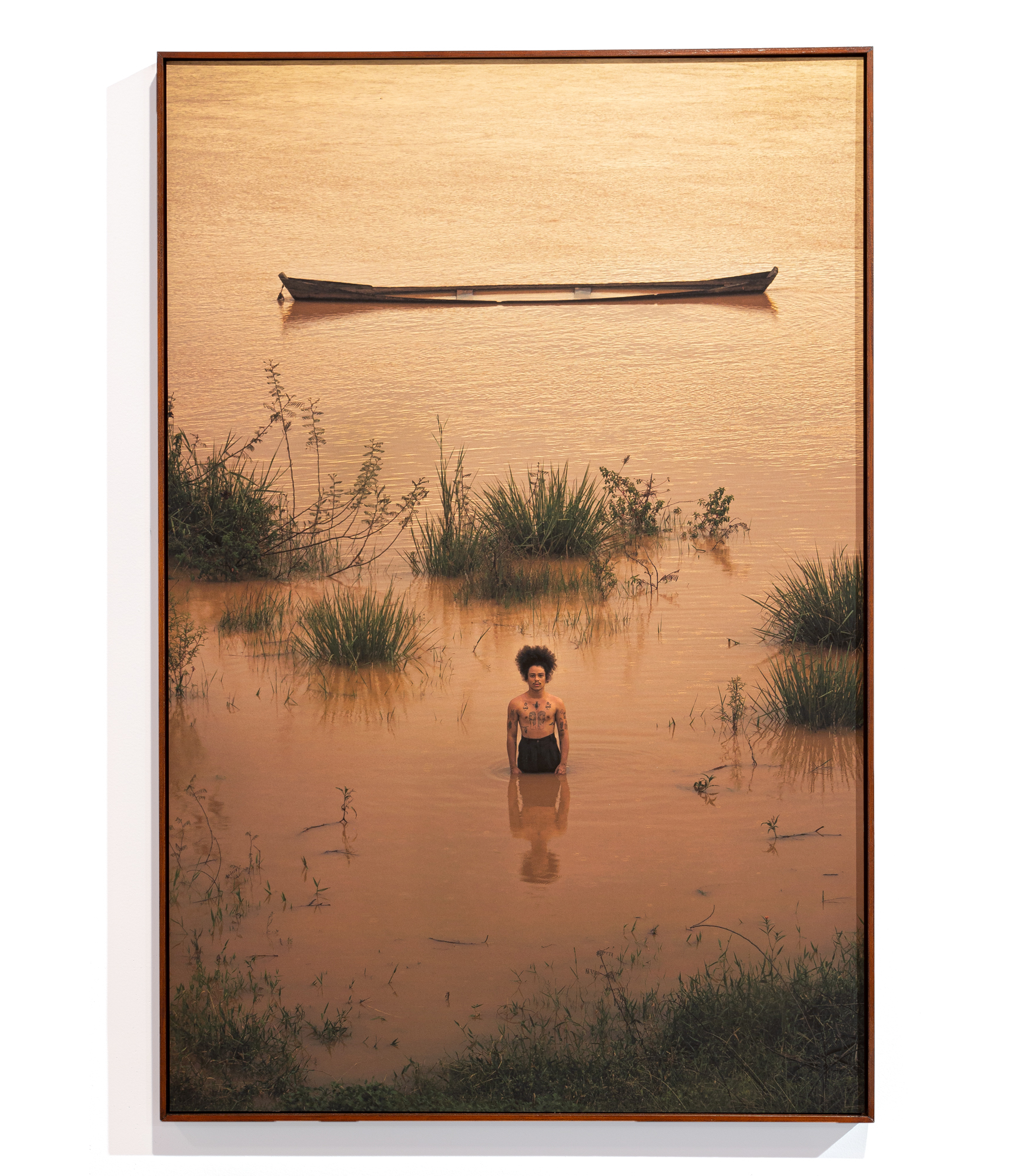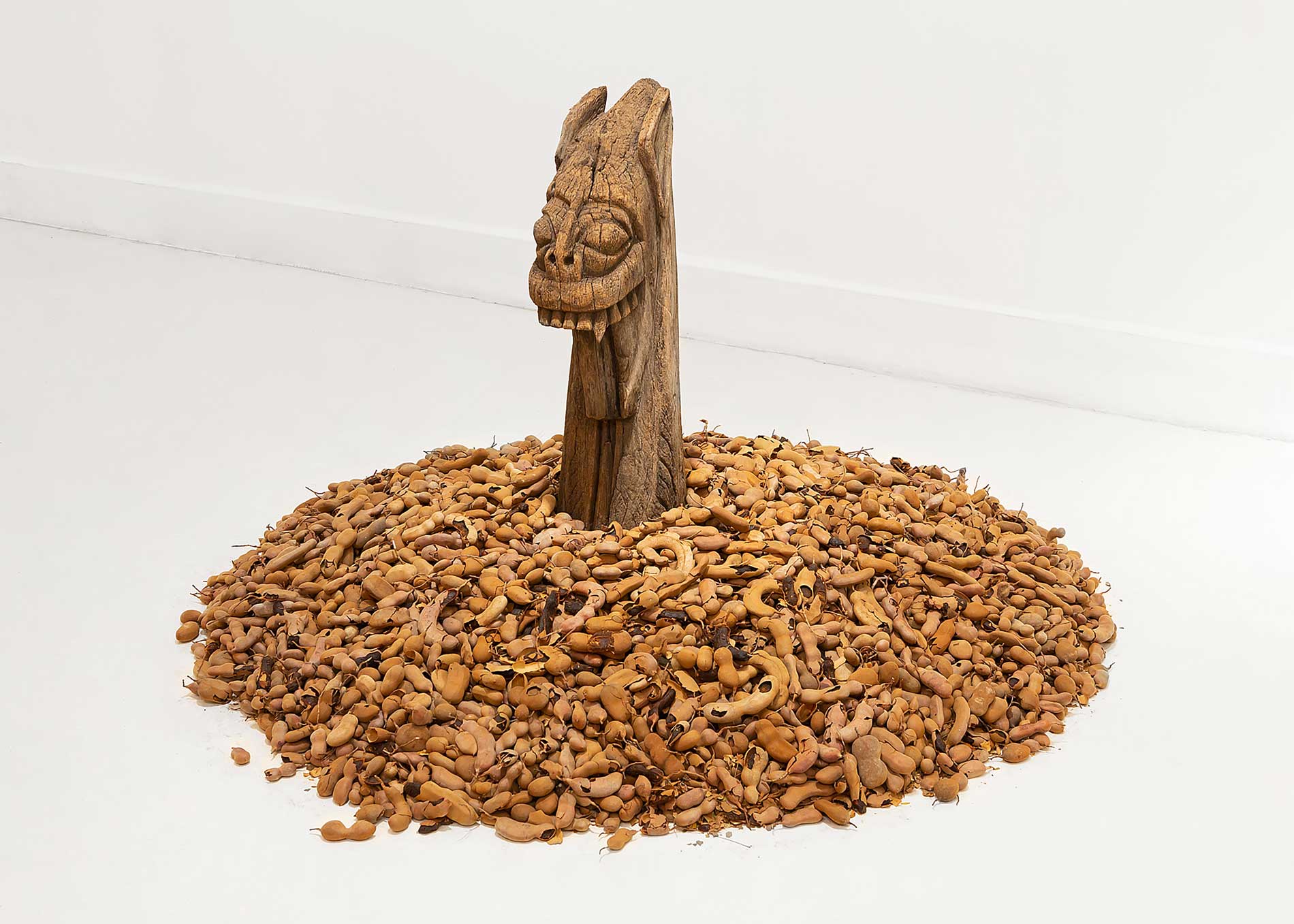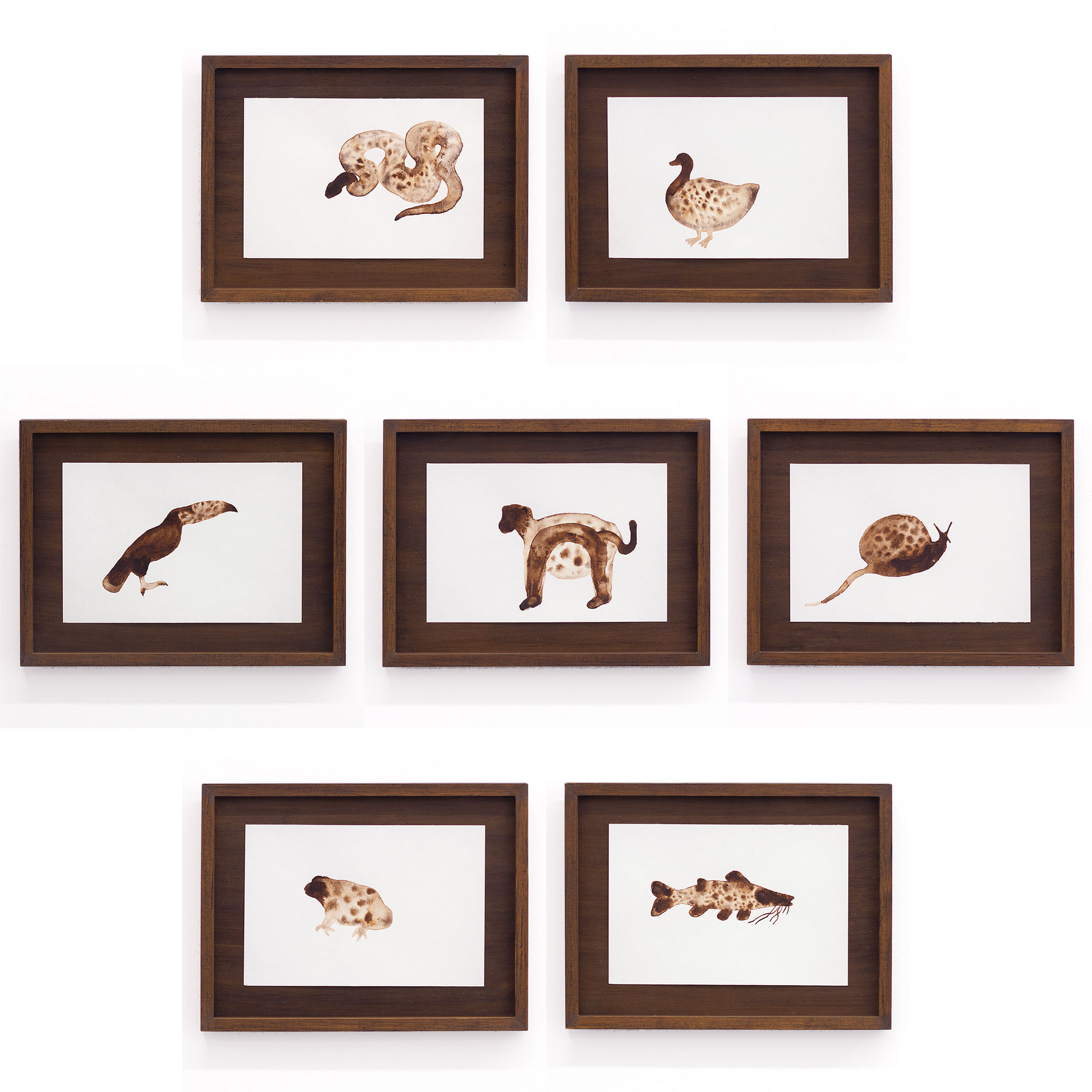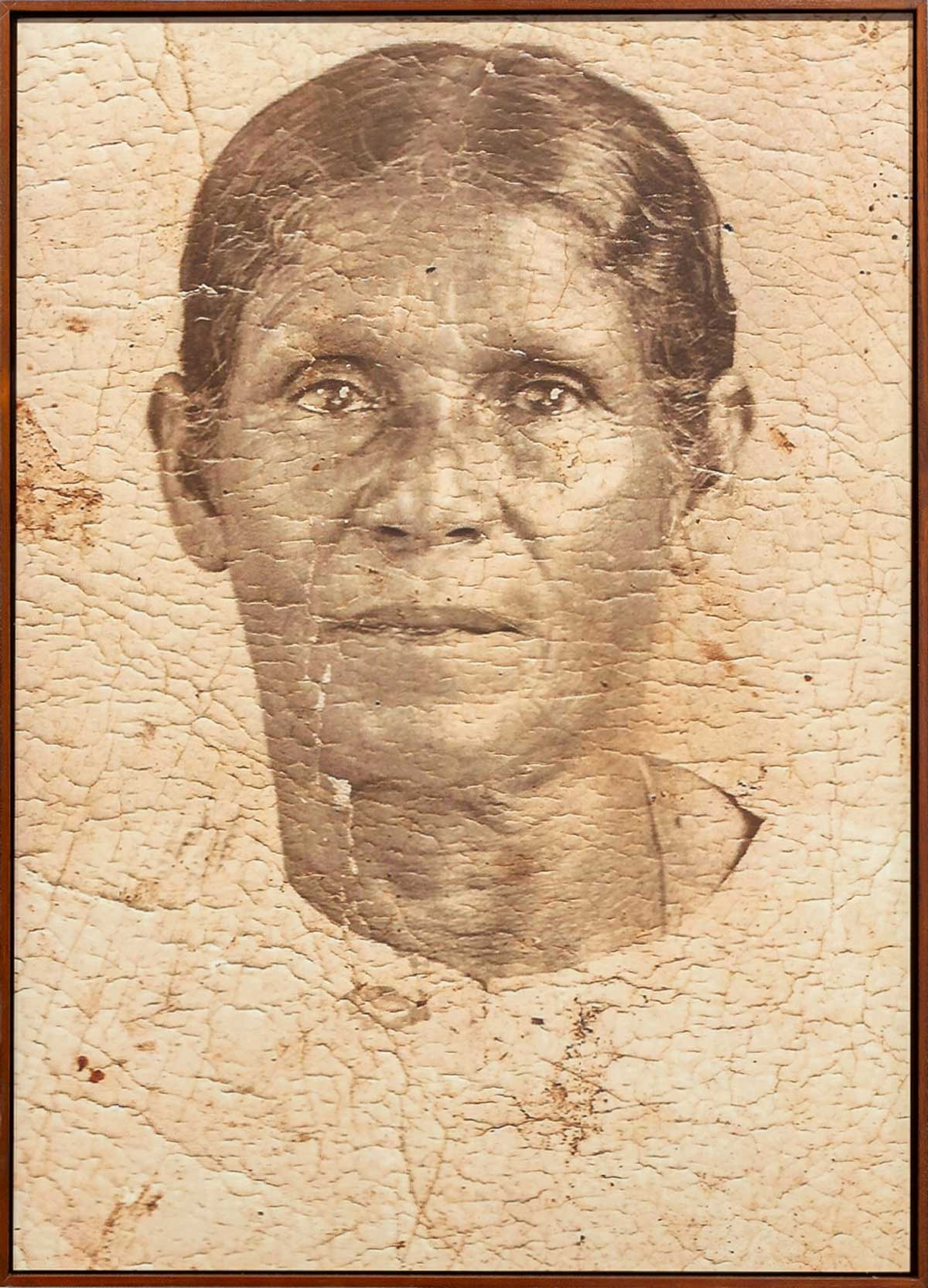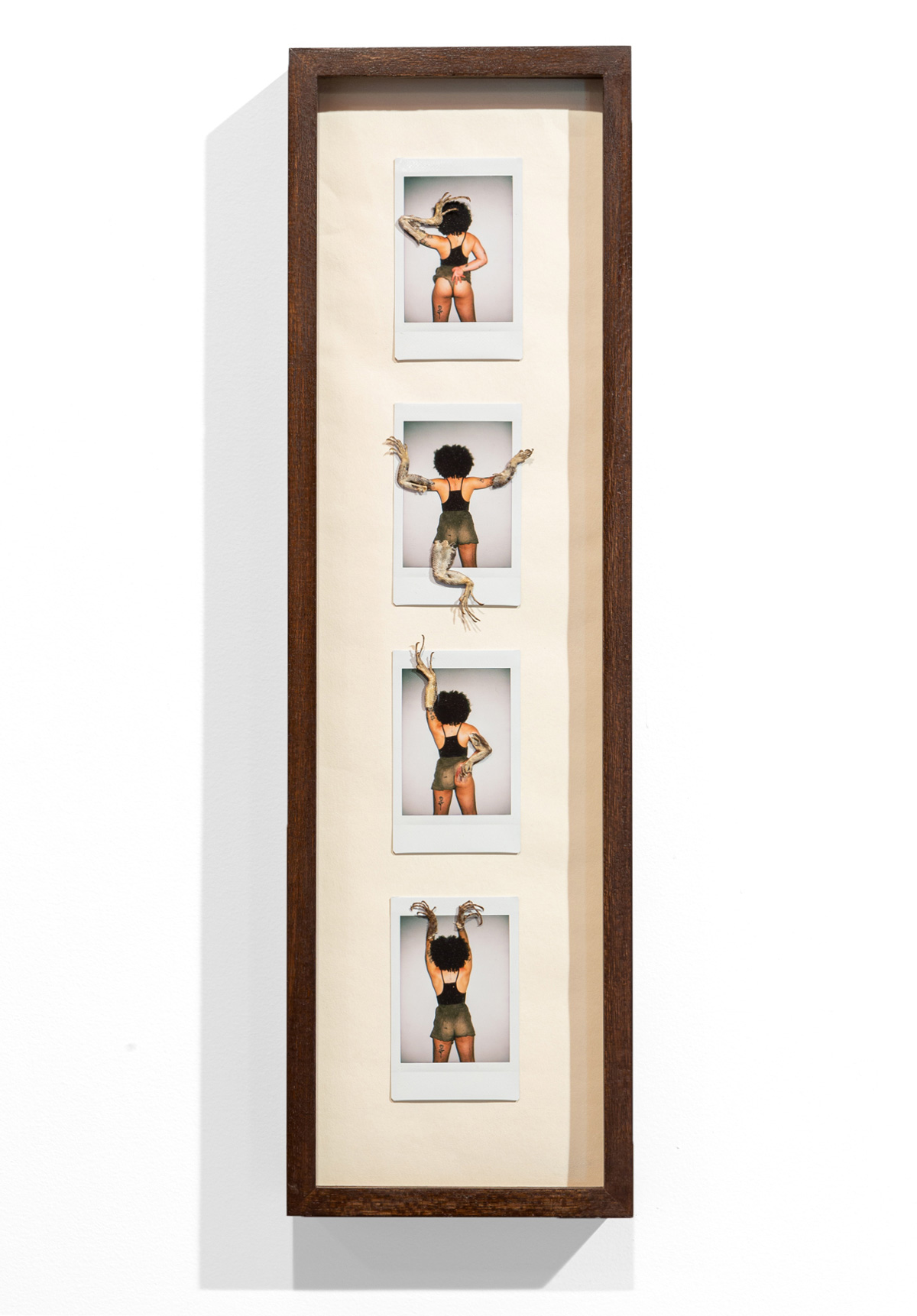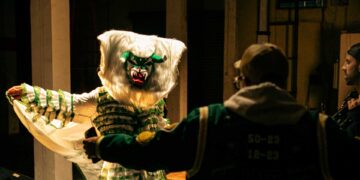Lips curve involuntarily, eyes widen and then quickly narrow, brow furrows. It is at this moment that the tip of the tongue seeks to apprehend thecomplexity of such a unique taste. When a face encounters the flavor of the tamarind, flashes of surprise and intensity seem to be investigating each expression.
There goes a grimace, a scowl of bewilderment, but also of fascination, as if the mind were processing the gustatory experience and deciding whether to celebrate or challenge such an unexpected encounter.
There is a vivacity in the facial expression, a vigor which transcends the mere act of eating. It is as if the face were engaged in a momentary dialogue with the food, exchanging impressions and reactions. As the acidity dissipates, a shy smile or a soft laugh commonly emerges.
This alliance between the sweet and the sour has an amber hue and is a distinct characteristic of the tamarind – a fruit with a velvety peel, sculptural shapes and earthy tones, like small chips of wet soil or damp tree trunks. Abundant in the warm regions of the São Francisco River, tamarinds, hanging from their leaves, are often confused with the animal creatures of the land, but could also be pieces of wood carved in a carranca [scowling face].
When trying tamarind, our features follow the experience of the tongue that encounters a peculiar taste, resembling the carrancas that historically protect boats and houses along the São Francisco River. It is believed that this expression of astonishment chases evil spirits away and calms the waters. For riverine communities, there is no greater shield than keeping their faith alight on the prows.
The connection between the tamarind and the carranca invokes the entire secular spiritual dimension that the faces of humans and animals bear – especially when they merge – showing exaggerated expressions of amazement, expulsion and combat. This visual, symbolic, and cultural correspondence is just one of the windows for entering davi de jesus do nascimento’s work, helping us to craft a poetic journey that can account for this immense universe of fables, this coming together of the waters.
To capture the nuances of davi’s work, we must embody the carranca as it evolves – as he defines it – and look into it, with our ears as doors.
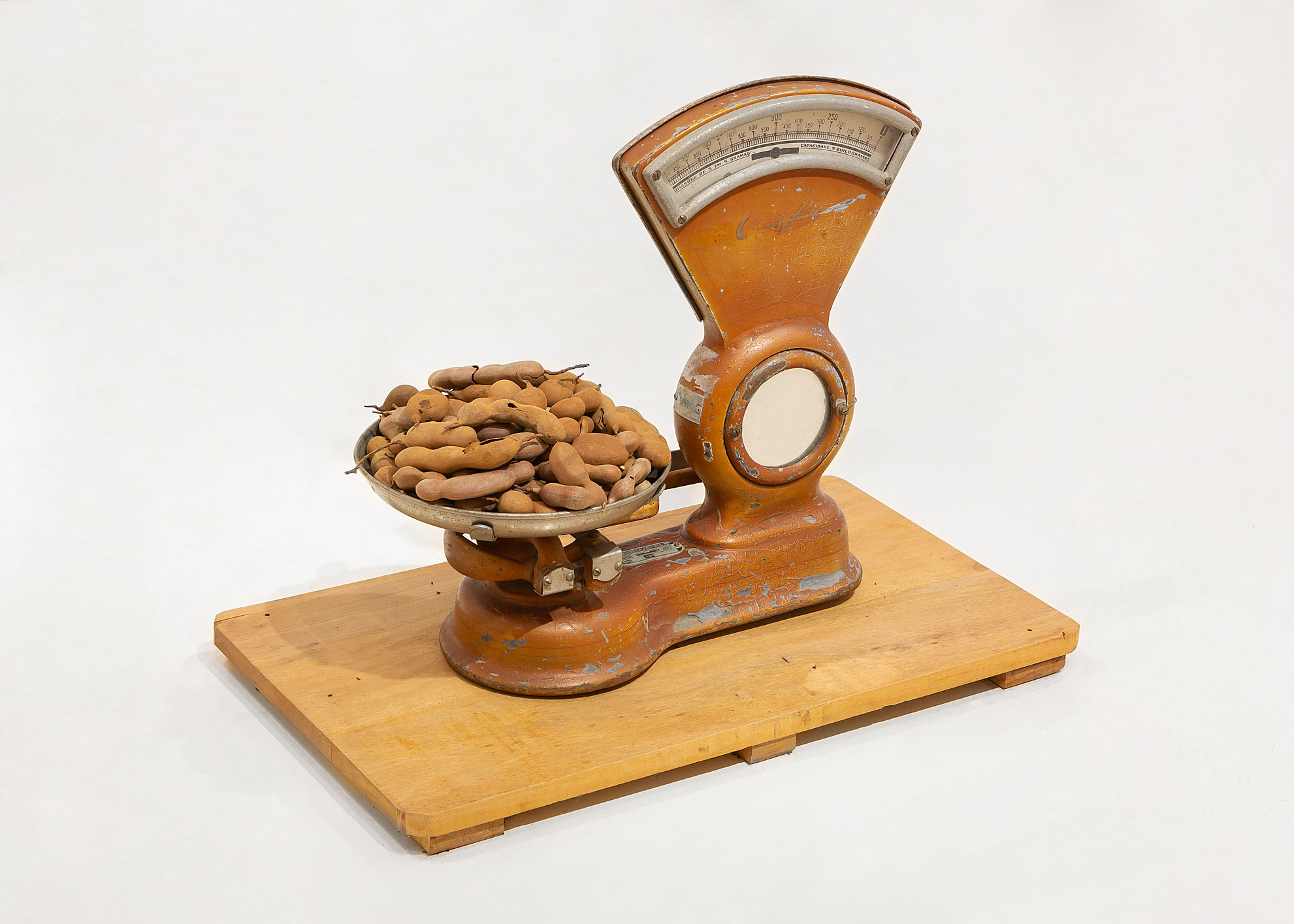
Davi de Jesus do Nascimento, carne de sol, 2022, objeto de águas guardadas, balança com tamarindos, 20.5 x 10.5 inches. Photo: Courtesy of Mitre Gallery.
II
Imagine swimming in a river of tamarinds, imagine manatee carcasses emerging from your back at dusk. Imagine a pink cradle to lull shoals of fish and a boy who, from staring at a carranca so much, merges with the prow and is seen on the boats every morning.
By imagining, we see. And that’s how Davi shows us the enchantments of his people and his territory. A riverine artist, with skin like river mud and the words of one who carries the memory of fish in his mouth, his origin comes from the waters of the São Francisco River. As a child, he saw snails come out of his grandmother’s varicose veins and hugged people to capture the aroma of the fruits they ate. With radiant and curious eyes, Davi saturates the reality around him with poetic filters, evoking the purity contained in things as they really are, in things as they could also be, or in things when they take on unforeseen purposes.
These are the longings that bathe his work. Memories of a time we have all lived, when innocence turns into simple and spontaneous gestures, in a world that is new and exciting with each discovery. Following Davi the artist is also getting to know a bit of Davi as a child, as if we were rewinding VHS tapes that held the secrets and joys of the Nascimento family. The universe of the clay-sculpted boy, who grew up among tadpoles, on the ravines of the São Francisco river, from [Minas] Gerais, with his master carranca-maker cousin, his master boatman father and his mother under the spell of the waters of the river.
And through the loveliness of the sensitive gaze of one who is kin of the land, we also find the difficult enunciations of his adult reality, attesting to changes in the landscape, the abating waters, the deforested shores, transformations caused by the interference of systems created to sicken the rivers, through sedimentation, transposition, drought, and breached dams (2). Macro-procedures that are present in the daily lives of riverine communities and cause forced diasporic movements of families along the length of the great river that traverses various Brazilian states.
This is also the story of his family from Bahia arriving in Pirapora in 1975, during the golden days of the port city, when the auspicious event of the evening was the arrival of traditional steamboats. Between the 19th and 20th centuries, the transfer of passengers and goods between the Northeast and North of Minas fueled the region’s economy and turned municipalities of the hinterlands into burgeoning places of upscale tourism and cultural diversity (3). Despite steamship navigation’s status as an imperial symbol, it was the main means of transportation over the extensive navigable stretch of the São Francisco River, until banned due to the risk of accidents caused by silted sandbanks – just one more example of the impact that extractive culture has had on traditional communities and their freedom of movement. The city of Pirapora is the raw material of Davi de Jesus’ work, the place from which his practice converses with the world; the city’s history is an important chapter to understand riverine Brazil and migratory processes within the country.
Davi de Jesus do Nascimento, Enlace, 2018, digital photography, 31.5 x 18 inches. Courtesy of Mitre Gallery.
III
The flow of time that each place demands speaks volumes about Davi’s work. Just like the pause to contemplate the horizon from a boat, the artist regales us with the reiteration and recurrence of his images, words, inventive stories, and, mainly, the narrative of his territory. With almost a decade devoted to artwork, Davi continues to dream, to listen and to confabulate with the São Francisco River, which, in turn, constantly summons him.
Moreover, his listening also encompasses the wisdom of grandmothers, fishers, insects, riverbanks, and carrancas. With lingering persistence, he insists on the insistence of work that is not restricted to being a research theme. On the contrary: themes do not sustain themselves over time. For Davi, to make art is to transmute into matter beyond his body. Or rather, a material composition where it is possible to expand all the senses of the body so that communication can occur in multiple ways.
And hence, stubbornness is necessary – since objects, beings, drawings, waterings, images and appearances pursue the artist and claim presence. It is a repertoire of images belonging to a unique context that occasionally reappears in the imagination of a people. It is said that no matter how many times attempts are made to kill a river, there will always be a new source ready to spout. Persistence is adaptation and continuous flow searching for a destination.
Through constancy, Davi de Jesus do Nascimento plunges deep into conceptual fields that support his work and offer us possibilities for expanded studies, ones that may open subsidiary discussions about his artistic universe. It is possible to trace various readings that take his work as a point of reference.
Here, I propose to traverse three themes that I believe are pertinent to his research: family, amulets, and monstrosity.
Image top left: Davi de Jesus do Nascimento, fragmento de “gemer carranca naufragada”. Image top right: Davi de Jesus do Nascimento, Furor de Peito e Remela, Sailing vessel with spills from the series “Gritos de Alerta“, 2022. Image bellow: Davi de Jesus do Nascimento, Davi de Jesus do Nascimento, Aguamentos Barranqueiros da série “Sorvedouro”, 2022, watercolor on paper, 6×8 inches each. Photos: Courtesy of Mitre Gallery.
Family
In a video, Davi’s sister introduces two dogs, Rodela and Lessi, three rabbits, Teca, Nica and Minnie, and a pair of parrots, Sandy and Junior. The camera then shows the ambience of their backyard, and moves on to the kitchen, at Sunday dinner, describing each family member as if it were a news report. On that occasion, uncles, nieces, parents, children, and grandparents eat a traditional fish dish, catfish moqueca, together. It is a 3’57” VHS camcorder recording of an ordinary family day, projected on a wooden box with water, under the title “fish stew with pepper”, during Davi’s (4) second solo exhibition. One of the first works conceived in collaboration with his father Davi (from whom the artist inherits the name), it is also one way, among so many others, to reactivate memories of everyday family life, redefining experiences of mourning, longing, conflict, and healing.
Making home movies and photos was a common practice throughout Davi’s childhood – and that of his siblings and cousins – during the 1990s and early 2000s. It left records of children growing up, traditional festivities and the impact of human actions on the course of the São Francisco River. In addition to constituting an important document for observation of the context and region, these photos and videos provide access to a legacy of image and the right to memory, something that has been denied to many ethno-racialized and socially vulnerable families.
What we see (and take part in) through these images consists of chosen leisure moments deemed worthy of remembrance, for posterity. They became part of a collection of video tapes – remastered to DVD – and of numerous photo albums. By becoming acquainted with this set of pieces, we are able to identify choices, priorities, intimacy and bonds of affection. They are markers of moments that really matter – precise and unique choices, decisions that have been stolen from us by today’s digital cameras.
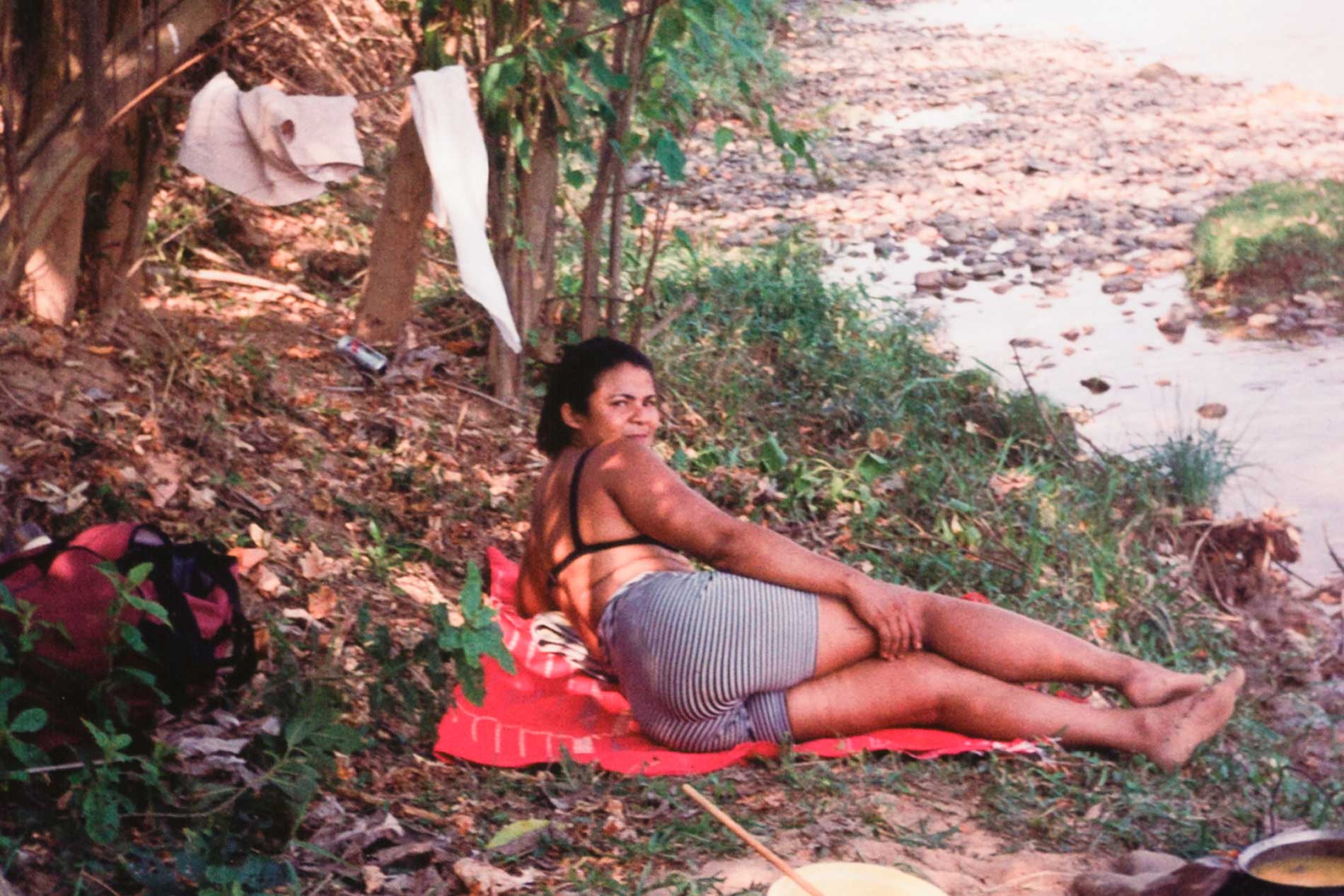
Davi de Jesus do Nascimento: Calmon Island, 2023, Retrato-enchente de nossa mãe, analog family photograph, soaking bud in development, 39 x 27 inches. Photo: Courtesy of Mitre Gallery.
Another important characteristic of this collection can be found in its “flood portraits”, faces of family members with serious and attentive expressions – the type of photos used in documents. Enlarged, printed safeguards of the traces of the passing of time, these images, when exhibited, gain the poetic touch of the artist, attesting to the intimate life stories of great-grandfather João das Queimadas, great-great-grandmother Ana Josefa Paixão, uncle Neno and grandmother Joaninha.
Over time, Davi has chosen to become the guardian of this treasure, gathering records of close and distant relatives in a collection. The family collection has stirred up whirlpools in his work, through gestures of “remoistening” the images, and shoring up the presence of his ancestors and ancestralities, in reverence to them. Through the series titled “observation hole”[butuca em remolho], we also become acquainted with the smile of his mother, Eliane Vieira do Nascimento, who passed away prematurely. His mother’s passing – her ‘enchantment’ – was a decisive milestone in his life, feeding his personal confirmation to pursue an artistic career and nourishing familial reconfiguration, notably his reconnection to his father and brother.
For those who know Davi and the way he works, it quickly becomes apparent that the collaboration and consent of his family in the creation of his works are determining factors. Furthermore, having the appropriate conditions for a faithful and honest presentation of his community. This is because his work starts from the São Francisco River with the integral purpose of healing family wounds, the social traumas engraved on his dissident body, as a young boy living in a small town, and the collective anxieties of a people who are relatives of a river that has become the object of persistent policies of death. Thus, his entire artwork is a moving letter of love to his mother, a genuine attempt to share with her the journey of their people and their land.
Left image: Davi de Jesus do Nascimento, Retrato-Enchente de Minha Tataravó Ana Josefa Paixão, 2013-2022, analog photograph from the family collection, 23 x 15 inches. Right image: Davi de Jesus do Nascimento, Retrato-Enchente de tio Neno, 2013-2022, analog photograph from the family collection, 23 x 15 inches. Both images are from the series “Flood Portraits”. Photos: Courtesy of Mitre Gallery.
Hence, the watercolors, or rather, “riverside waterings” as the artist calls them, especially the series “the river current buzzes silences” and “for a drying up” depict scenes of neighbors, friends, acquaintances, and strangers to his town, yet ones that can extend to all towns along the great São Francisco. Apparitions of waterlogged bodies, almost deformed, allude to collective moments of communion with the river, but also to the lamentations of floods and inundations. The works show us the people of this land, their bodies made of brown clay.
As a methodology to never forget the non-negotiable, the artist has invited his father to collaborate on sculptural works, videos, and photographs. In turn, Davi, a fisher and master boatman, acquires, with the help of his son, a new understanding of art, different from the carpentry that builds boats, furniture and musical instruments; it is one that converses with the symbolic capital of major art exhibitions and institutions. In Davi’s recent exhibits, the presence of boats is constant, sometimes whole, sometimes in parts – like oratories, tamarind houses, silencing boxes or prows that map a route through space – all works whose authorship he shares with his father, Davi Nascimento. One of the most emblematic works of this collaboration is “singra” (5), a project designed for an online festival, in which the entire process of building a sailboat, its launching and subsequent navigation are followed, step by step, through photos and videos by Caio Esgario, the artist’s life partner. Amid the boatman’s labor, Davi engages in a dialogue with his father’s gestures, through studies of body and sound.
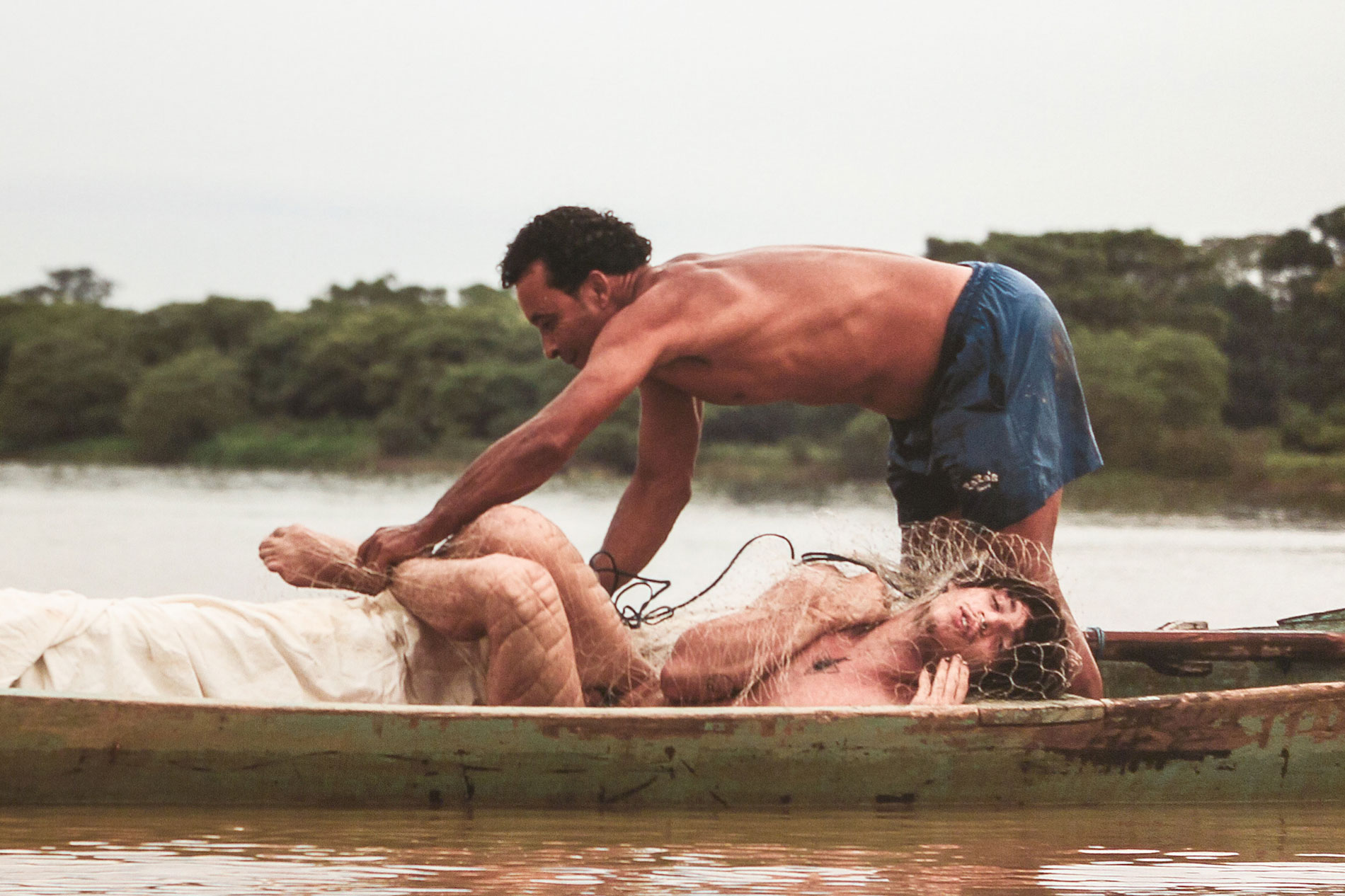
Davi de Jesus do Nascimento, pesca-ameaça de naufrágio da barca ou ensaio para morrer com o rio, 2016, engasgo de espinha, digital photography, 18 x 39 inches. Photo: Courtesy of Mitre Gallery.
Amulets
As an artistic project for the Bolsa Pampulha 2019 Grant Award, Davi carried a 20-kilogram carranca through the streets of Belo Horizonte over a six-month period. The action represented something new to his work, a gesture of combat that would fortify him in the process of adapting to his new city of residence – since frowning faces are sacred protective sculptures and a familiar element for the artist. However, “body-boat” went beyond initial expectations and transmuted into a rite of passage, an event that moved beyond the categories of art itself. Time expanded, and a project that was supposed to last for months lasted a year; carranca and body merged into a unique whole that underwent flashes of torment and ecstasy.
The proposal was born as a performance, but the artist soon realized that initial categories would not capture the entire bodily and spiritual experience. Putting up with the physical exhaustion that was part of the process, Davi’s insistence on sacrifice elevated his action to a spiritual journey of self-discovery, healing and reconciling with his roots and homeland(6). Of the artistic remnants, the analog Kodak PLUS-X 125 photograph, “body-boat” stands out as the cornerstone that authorizes the beginning of a journey. The act of carrying the carranca on his back is one, amongst the many events that Davi de Jesus investigates, in which the boundaries between life and art are always overflowing.
Many emblematic elements that are part of the riverine culture are summoned to join in as co-authors of Davi’s artistic thinking. They are present as amulets of protection and courage, of listening to the territory. They communicate constantly with the artist, instructing him on the way they want to be brought in and disseminated throughout the external world. This is his relationship to the carranca, as they appear in drawings and videos, or in fishing nets when they materialize as installations in the “mumps” series, along with tamarinds, animal carcasses, branches and other “objects of stored waters” brought in by the river.
“warning cries” is an example of such listening. The series, initiated during the pandemic to provide a breath of fresh air amidst its fears, uncertainty, and resource instability, now occupies a prominent place within his work. Thousands of individually or group-drawn carrancas populate the aesthetic imaginary that pertains to the entirety of his oeuvre. With expressions that scream and shout out in warning, they appear in different stances: devouring each other, standing up, lying down, falling, dancing. Like an incantation, they were responsible for inaugurating the artist’s financial independence, getting his work onto the art market and – following the currents – continually conveying his name to the national art scene. The carrancas on alert work like a spell, and they are relentless.
Davi de Jesus do Nascimento: Derranhos from the series “Gritos de Alerta“, 2023, brown pencil on hahnemühle 120g paper, . Photos: Courtesy of Mitre Gallery.
As for his sculpted carranca, carved by Master Expedito Viana Rodrigues – a reference in the region which currently stands watch over his house – it was recently displayed (7) as part of the work “to moan wrecked scowl”. The latter is made up of a pair of videos in which the artist mediates the conversation between the carranca and the river, washes the carranca with fresh river water in a gesture of blessing, and treats it like a scent-sniffing creature. The moving images are part of the continuously evolving “body-boat studies” series.
Meanwhile, the tamarinds fill candy bowls, nets, boats, and whole environments, emitting their sweet and sour smell beyond the exhibit spaces occupied by the artist. It is said that, when one passes close to or far from museums and art centers that have already hosted Davi’s works, their scent can be captured, remaining on the wind, emanating the memory and spirituality of the river for many years thereafter.
Davi de Jesus do Nascimento, fragmento de “gemer carranca naufragada”, digital video. Courtesy of Mitre Gallery.

Davi de Jesus do Nascimento, nutre acre, 2023, objeto de águas guardadas, rotating candy dispenser with tamarinds, 12 x 17 x 16 inches. Photo: Courtesy of Mitre Gallery.
Monstrosity
A body that is half human, half scorpion, catfish, lizard, or owl: in “exorcism of pain”, we repeatedly see Davi from behind, revealing parts of his body when he metamorphoses into an animal. This beautiful series of polaroids, which was begun in 2018 and evolves continuously, is a portrayal of the body when it overflows boundaries, when it flows beyond the parameters of social ‘normativity’.
Finding carcasses and pieces of animals on the ground in Pirapora, already in an advanced stage of natural mummification – favored by the dry climate of the region, which quickly dehydrates tissues while preserving the external features of organisms – Davi experiences other versions of himself by sewing or “accustoming” (8) new bodies to his own. The result shows how his identity incorporates his context of origin and, more than that, affirms and celebrates the multiple existences that belong there, from the human to the non-human and their hybrids. The photographic series also brings to the debate a cosmo-perception that challenges oppressive and tyrannical relationships between species, severing hierarchies from the purposes that capital and extractivism have allocated to them and anchoring living beings in a natural environment of co-participation and communion. In other words, these are splinters of magic invoking the Afro-Indigenous intellectualities that stretch out over the entire length of the São Francisco River.
Davi de Jesus do Nascimento, Água Guardada, da séris “Exorcismo de Dor”, 2021, lacerated lizard and instant photographs on paper, 18 x 5 inches. Photo: Courtesy of Mitre Gallery.
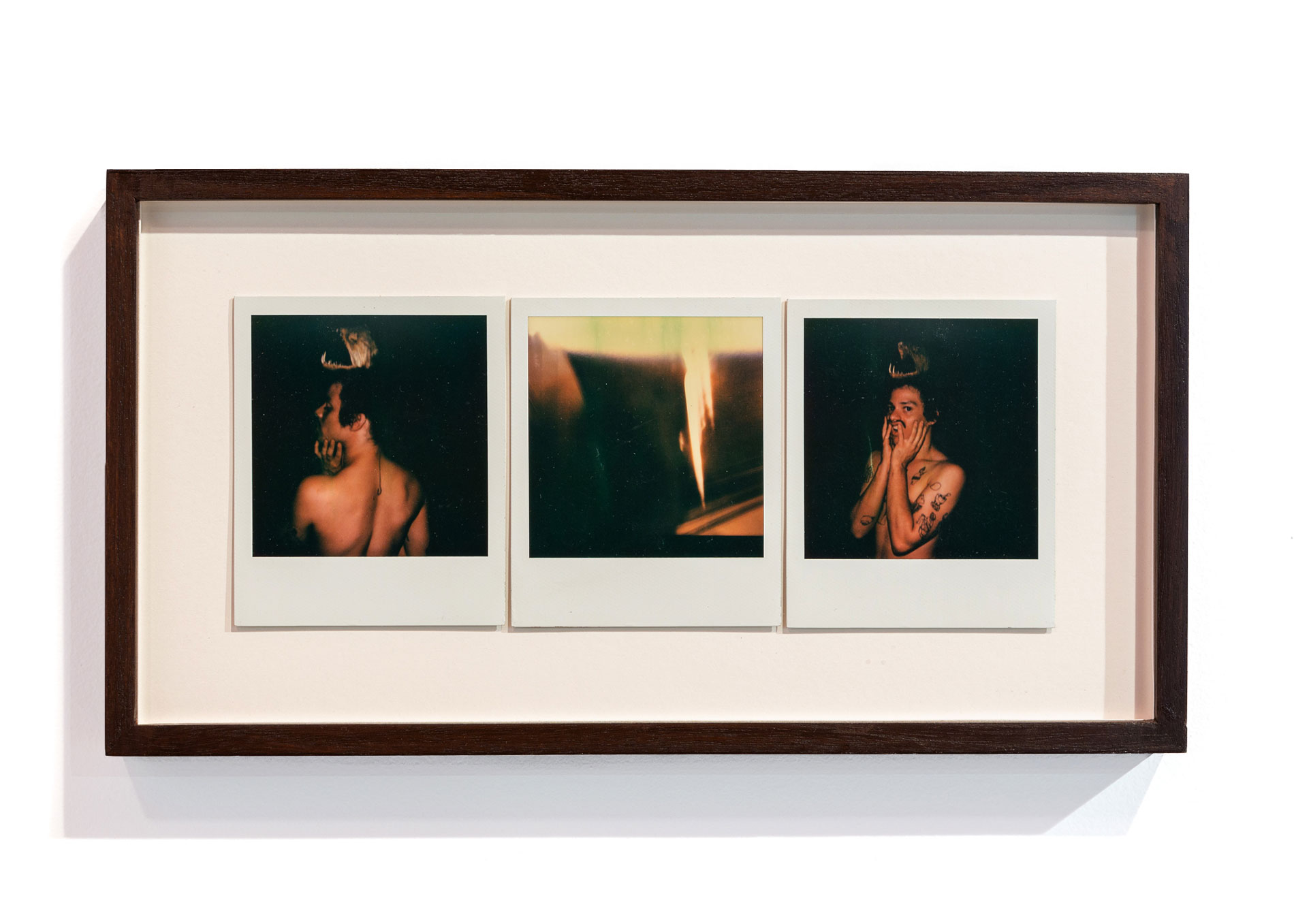
Davi de Jesus do Nascimento, Estudos de Corpo-Embarcação, 2018, instant photographs on paper, 8.5 x 25 inches. Photo: Courtesy of Mitre Gallery.
In further echoes from this territory, we add other ritual works that express the artist’s identity, composed with the fluidity of a river that runs its course. This is so for the photographic essay “fishing-threat of shipwreck” or “rehearsal for dying with the river”, that Davi made in collaboration with his father and brother, inspired in a dream he had. In the scenes portrayed, Davi’s father casts a net into the river to fish for his son Davi. This is the case for the photographs entitled “abundant fishing”, in which Davi poses while lifting a yellow fish on his shoulders, and “dry port bitterness”, where from the prow of an abandoned boat, Davi turns into a carranca – the latter through the lens of his brother Bicho Carranca. In the realm of experiments of communication between bodies, the artist has produced a series of short videos about his studies of movement, alluding to the dance of the whirlwind over dry land (9), either in direct conversation with the varicose roots of the Rio das Velhas or in impeccable harmony with the clucking of the neighborhood chickens.
This set of works is central to iconographic and theoretical debates of our day, in discussing the overlap of Queer Theory, theories of monstrosity and ecology, intersected by race and geography. By poetically revealing his mystery, which has something of an essentialist nature to it, the artist falls into the category that social ‘normativity’ identifies as demonic, monstrous, abnormal; he personifies existences that for centuries have been described as wild, causing responses ranging from fear to attraction. Not surprisingly, discussions about monstrosity have gained increasing prominence globally, in an effort to award subjective density to dissident sex/gender experiences, and especially the racialized and subaltern queer body.
Providing support for the study that unveils the various forms of life coming from the river, the “waterings” of the “sinkhole” series announce entities that hail from the clay that touches the deepest waters of the São Francisco river. The title refers to the natural phenomenon in which water, often very rapidly and powerfully, is absorbed or sucked in, as in a hole, abyss, or vortex, forming underground currents, caverns, or specific geological formations. The idea of absorption here encompasses three different meanings: impregnation, understanding and washing away.
For some Indigenous cultures in the region or nearby, underworld beings care for the balance of the earth and are the owners of its natural resources. Hence, the monstrous beings portrayed by Davi de Jesus, often narrated during their gestation, pop to the surface to be recognized through their stories, voices, and scents.
Davi de Jesus do Nascimento, pesca farta, printed instant photograph, 2018. Photo: Courtesy of Mitre Gallery.
Davi de Jesus do Nascimento (Born in Pirapora, 1997) resides and works in Pirapora, Minas Gerais, Brazil. He is a riverbank artist, raised along the shores of the São Francisco River—a watercourse that forms the essence of his life and artistic practice. Born into a family of fishermen, washerwomen, and carranqueiros (masters of the figureheads tradition), Nascimento engages in paintings, drawings, performances, videos, photographs, and texts, all imbued with a spiritual essence. His creative expressions draw from experiences, memories, and imaginations connected to his territory, community, and family. Through the unfolding of new existential possibilities for earthly elements, he proposes peculiar interspecies relationships and sees metamorphosis as an inevitable destiny. nascimento’s dense and atmospheric scenarios are enveloped in a sentimental mood and a certain temperature that outline a unique visual and semantic universe.
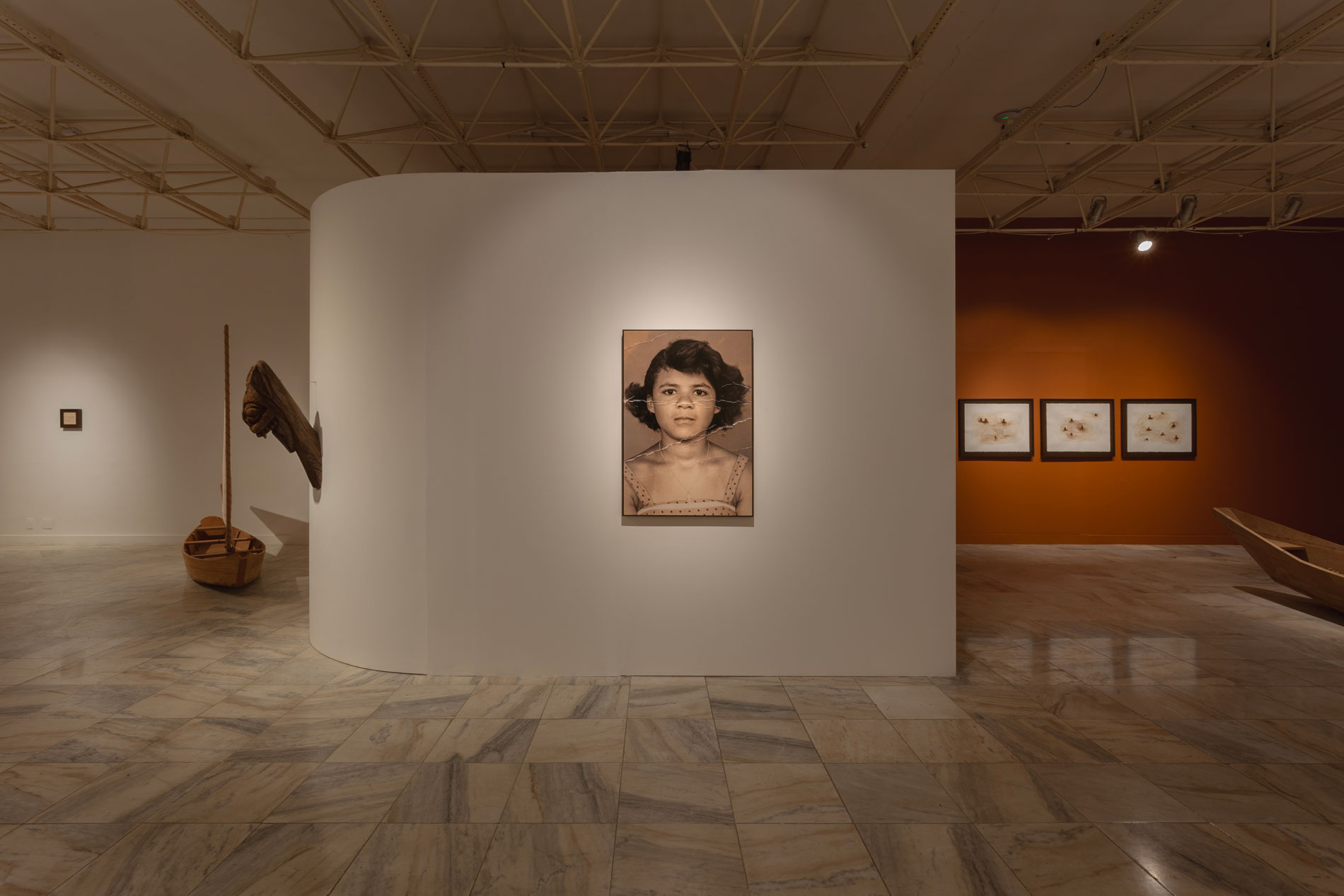
Madeira Doce, Água Áspera exhibition, Palácio das Artes, Belo Horizonte, 2023. Photo: Courtesy of Mitre Gallery.
1. Karranca Groove is the title of the song by Marku Ribas, and the fifth track on disc 2 of his album “Marku 50 – Batuki, Parda Pele, Atavu”, 2013. Here, I chose it as an expression that denotes harmony and continuity with the carranca. “Groove” is often associated with an infectious, captivating rhythmic sensation that makes people want to dance or move to the beat of the music.
2. In a conversation with the artist, he expresses the opinion that dams are the artifice that most damages the life of rivers. River dams are structures built to hold back water, creating human-made reservoirs.
3. Pirapora, for example, was the destination of many MPB artists such as Alceu Valença, Sá and Guarabyra, among others, and home to the riverine musician Marku Ribas. The 1977 album, made by the duo Sá and Guarabyra, was composed in honor of Pirapora, especially the two songs “Trem de Pirapora” and “Cinamomo”.
4. O Suor da Testa Mora dentro dos Marimbondos was the artist’s second solo exhibit, held at Memorial Minas Gerais Vale, between October and December 2019. Curated by Júlio Martins.
5. singra was commissioned for the Seres-rios Festival in 2021. The artist worked collaboratively with his father Davi de Jesus do Nascimento, and with Caio Esgario. The work is featured on his website at: seresrios.org/davi-de-jesus-do-nascimento/
6. By carrying the carranca, Davi also carries the cultural reference associated with his homeland. This symbolism becomes evident when we learn that the carranca used in “body-boat” belonged to the musician Marku Ribas, coming to him on loan from his friend, Lira Ribas, daughter of the riverine musician.
7. A work exhibited in “evils of the tongue”, on exhibit in Museu Paranaense, in Curitiba, from December 2023 to March 2024.
8. A process in which the artist glues pieces of animals to photos.
9. In this series of works, Davi alludes to the whirlpool using the phrase “The Devil in the street, in the middle of the whirlpool”, in reference to the inspiration and direct influence he takes from writer Guimarães Rosa’s Grande Sertão Veredas. This famous work of Brazilian literature takes place, in part, in the northern region of Minas Gerais; the town of Pirapora is one of today’s tourist attractions related to their role in the novel.
All images of Davi’s work and the short biography text are courtesy of Mitre Gallery who represents the artist since 2021.
To get in touch with them: @mitregaleria / www.mitregaleria.com

